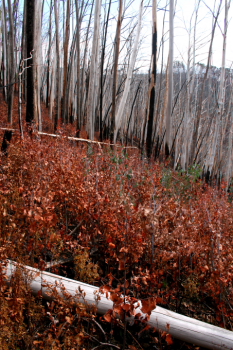
Forest Solutions
Confidence Experience Knowledge
Aiding Recovery, Assisting Restoration, and Building Resilience for Australia's Temperate Forests
Latest News
Ecological Thinning - a tool to assist recovery of forest biodiversity values. Trust For Nature seeks guidence from Forest Solutions to implement ecological thinning in out-of-reserve Box-Ironbark in Victoria.
Restoration Silviculture |
  
|
 Our skills also include the discipline of Restoration Silviculture, a growing trend world-wide, used to restore or monitor degraded forests in special reserves such as Regional and National Parks. In SE Australia, forests are damaged or are subjected to 'dieback' by agents such as bushfire, extreme weather, insects like psyllid, fauna population imbalances - both native and exotic (e.g. Bell Miners, Koalas), weed invasion, and fungal infections such as PC or Armillaria. Not all of these are caused naturally, but can be traced back to anthropogenic origins. These require monitoring and assessment as a minimum. Action can then be taken if policy aligns with the practical requirements of restoration.
Our skills also include the discipline of Restoration Silviculture, a growing trend world-wide, used to restore or monitor degraded forests in special reserves such as Regional and National Parks. In SE Australia, forests are damaged or are subjected to 'dieback' by agents such as bushfire, extreme weather, insects like psyllid, fauna population imbalances - both native and exotic (e.g. Bell Miners, Koalas), weed invasion, and fungal infections such as PC or Armillaria. Not all of these are caused naturally, but can be traced back to anthropogenic origins. These require monitoring and assessment as a minimum. Action can then be taken if policy aligns with the practical requirements of restoration.
For restoration, global trends and current Government Policy do not always align, indicating that Australia is currently behind in some developments. Silviculture is not just for commercial forests. In a time of climate uncertainty, reserved forests that may rapidly change will need active silvicultural management to survive and maintain resilience. Government organisation that manage reserved forest areas must adapt to these changes - and we can assist.
A prime example of recent change, linked to meteorological conditions, has been the change in Alpine Ash (Eucalyptus delegatensis) distribution and forest structure following the 2006/07 bushfires in Victoria. Precise change has yet to be documented accurately, but we already know that the decade-long drought, beginning in 1997/98 has had significant effects on Alpine Ash flowering frequency, resulting in a lack of seedcrops in forest canopies at the time the 2006/07 fire struck. Consequently, Ash boundaries are changing and retreating. The species may self-regenerate in places, but at very low densities, resulting in dramatically different forest structures.
The 2006/07 fires also re-burnt 100s of hectares of alpine Ash regrowth originating from the 2003 bushfire 3 years earlier (see accompanying image). These areas in National Parks will not regenerate. There was no seed source at all in these areas.
At a time when climate is forecast to dramatically reduce the resilience of these forests, Forest Solutions stands ready to actively manage or monitor these areas if consulted - in an attempt to reduce loss of forest cover and maintain the environmental and species integrity of our National Parks.
